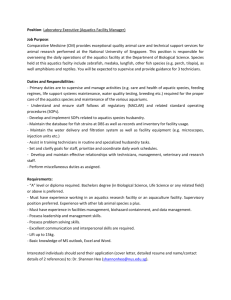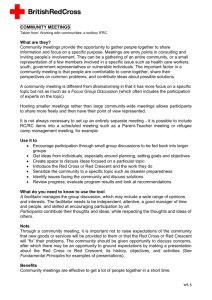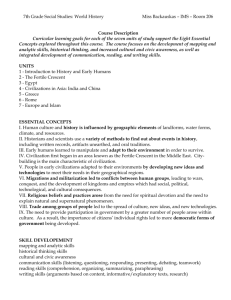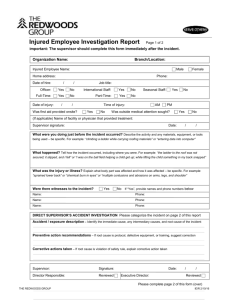Aquatics Leader Administrative Notes
advertisement
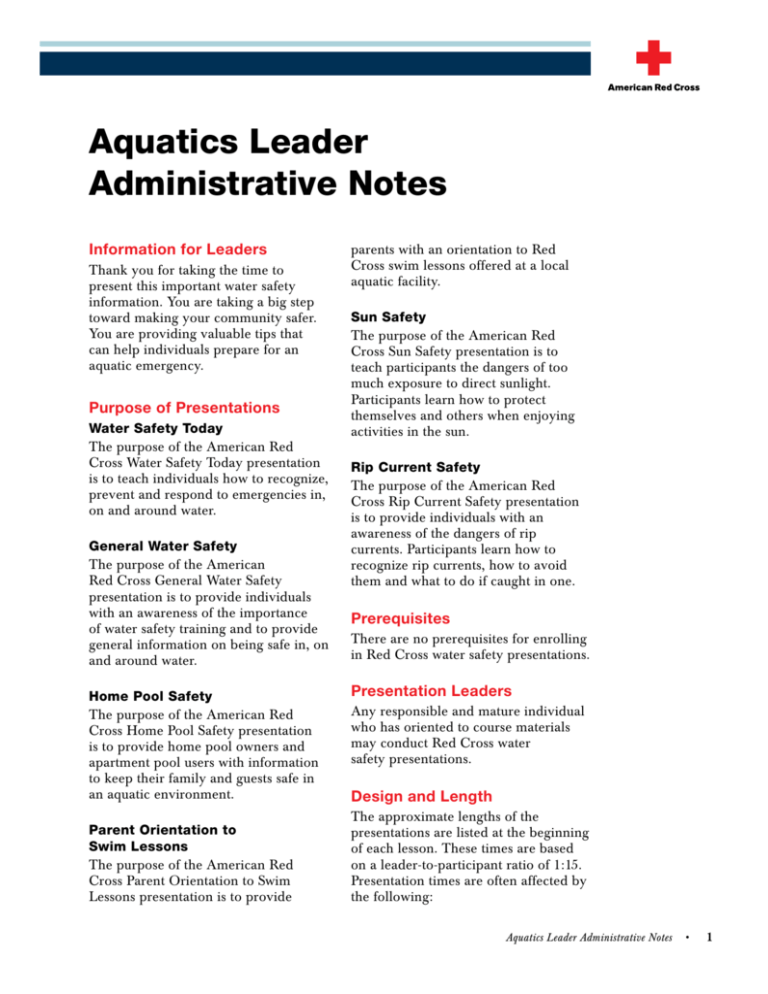
Aquatics Leader Administrative Notes Information for Leaders Thank you for taking the time to present this important water safety information. You are taking a big step toward making your community safer. You are providing valuable tips that can help individuals prepare for an aquatic emergency. Purpose of Presentations Water Safety Today The purpose of the American Red Cross Water Safety Today presentation is to teach individuals how to recognize, prevent and respond to emergencies in, on and around water. General Water Safety The purpose of the American Red Cross General Water Safety presentation is to provide individuals with an awareness of the importance of water safety training and to provide general information on being safe in, on and around water. Home Pool Safety The purpose of the American Red Cross Home Pool Safety presentation is to provide home pool owners and apartment pool users with information to keep their family and guests safe in an aquatic environment. parents with an orientation to Red Cross swim lessons offered at a local aquatic facility. Sun Safety The purpose of the American Red Cross Sun Safety presentation is to teach participants the dangers of too much exposure to direct sunlight. Participants learn how to protect themselves and others when enjoying activities in the sun. Rip Current Safety The purpose of the American Red Cross Rip Current Safety presentation is to provide individuals with an awareness of the dangers of rip currents. Participants learn how to recognize rip currents, how to avoid them and what to do if caught in one. Prerequisites There are no prerequisites for enrolling in Red Cross water safety presentations. Presentation Leaders Any responsible and mature individual who has oriented to course materials may conduct Red Cross water safety presentations. Design and Length The approximate lengths of the presentations are listed at the beginning of each lesson. These times are based on a leader-to-participant ratio of 1:15. Presentation times are often affected by the following: Parent Orientation to Swim Lessons The purpose of the American Red Cross Parent Orientation to Swim Lessons presentation is to provide Aquatics Leader Administrative Notes • Experience, abilities and skills of the participants n Needs, interests and desires of the participants n Number of participants n Amount of equipment and supplies n Experience, abilities and skills of the leader n Suggested Materials, Equipment and Supplies Required and optional equipment, materials and supplies are listed at the beginning of each lesson. Make sure all equipment is ready and in working condition before your presentation begins. o Wrap-up – Conclusion of the topic; it helps the leader move smoothly from one topic to the next o Participant Handouts Leader Responsibilities Your responsibilities when conducting a presentation are to— Provide n for the health and safety of participants by always ensuring that— o Participants are aware of health precautions and guidelines concerning the transmission of infectious diseases. o Participants know that they should consult with you if they have concerns about their physical ability to perform or participate in any of the skills. Conducting Presentations Before conducting a presentation, the leader should read through the lesson plan and review the appropriate participant materials. The lesson plan contains the following information: Lesson Name n Lesson and Topic Length n Materials, Equipment and Supplies n Lesson Purpose n Lesson Objectives n The lesson plan guides the leader through the presentation and includes the following: Key Terms and Definitions – Definitions n of terminology that may not be familiar to participants that will be introduced to participants for the first time in a lesson n Presentation Outline o Activities – Instructions for guided discussions and exercises o Leader’s Notes – Information that provides additional guidance to the leader o Skill Sessions – Skill demonstrations and practice of skills by participants • Aquatics Leader Administrative Notes The classroom and practice areas are free of hazards. n Be familiar with the presentation materials and training equipment, and know how to use them effectively. n Be familiar with the local Red Cross chapter services and be able to provide participants with information on training and volunteer opportunities with the Red Cross. Additional information is also available at www.redcross.org/services/ volunteer. n Create a non-threatening environment that encourages participants to achieve the learning objectives. n Adapt your teaching approach to match the experience and abilities of the participants. n Be prepared to answer participants’ questions or know where to find the answers. n Provide a positive example by showing healthy habits when interacting with participants. n Sign the Leader Agreement and Code of Conduct. The Leader Agreement o and Code of Conduct are signed by both the leader and a chapter representative. This agreement provides both parties with an outline of the mutual expectations, rights and responsibilities of the leader and the local Red Cross chapter. n Submit a completed Course Record (F6418) and Course Record Addendum (F6418A) to the sponsoring Red Cross chapter within established timeframes. n Abide by the obligations in the Leader Agreement, and if applicable, the Authorized Provider Agreement. These agreements are on-line at the Instructor’s Corner: www.redcross.org/ instructorscorner. Chapter Responsibilities The local Red Cross chapter is responsible for providing the highest level of customer service. The chapter does this by— Providing the leader with evaluation and appropriate reporting forms. n Communicating with leaders about new programs and volunteering opportunities. n Providing administration support. n Maintaining a current Authorized Provider Agreement. n Having needed materials and equipment available in a timely manner. n Health Precautions for Presentation Participants Ask participants to tell you in advance if they are concerned about their ability to perform a specific skill. People with certain health, medical or physical conditions may hesitate to take part in the skill sessions. Suggest that these participants check with their physician or health care provider before participating in skill sessions. Encourage them to participate to whatever extent possible. They may read the participant’s materials, watch skill sessions and take part in class activities. The American Red Cross recommends that leaders adjust activity levels to facilitate learning and to help meet presentation objectives whenever possible. Because this presentation does not award certification in first aid, CPR or AED, participants have the option of not participating in skill sessions. Lesson Plan Activities This presentation contains the following types of learning activities within the lesson plan: Small-Group Exercises Small-group exercises consist of two to four participants working together to solve a problem or complete an activity. The exercises allow participants to use one another’s knowledge to solve problems. Large-Group Exercises A large-group exercise uses large numbers of participants or the entire class to solve a problem or complete an activity. When the entire class works together, it provides an opportunity to exchange ideas, discuss a problem and think about the many ways to solve a problem. Interactive Discussions and Lectures Much of the information provided in the lesson plan is shared with the participants through interactive discussions in order to involve the participants in the learning process as much as possible. Presenting information via mini lectures is sometimes the most effective way to deliver information in a short period of time. The lectures in this lesson plan should be kept as brief as possible Aquatics Leader Administrative Notes • because of the passive nature of this method and the possibility of less effective learning. Conducting Skill Sessions Skill sessions should be well organized and well managed by the leader. When you are setting up the classroom, position the participants so that you are able to see everyone. The following template is used in most skill sessions: Leader Demonstration: The leader demonstrates the skill being referred to in the participant’s materials. n Leader-Led Practice: All participants move to the practice area. The leader leads half of the participants through each step of the skill, as a group, while the other half follows along with the appropriate participant’s materials. Then the leader has participants switch places so they can lead the second group. n Reciprocal Practice: Participants practice the skills, coaching one another and using the appropriate participant’s materials as a reference. During reciprocal practice time, the leader circulates among the participants to ensure that they are appropriately practicing skills and are receiving feedback from their partners. As the leader observes participants practicing skills, he or she provides positive and corrective feedback as appropriate. n Presentation Reporting Leaders should complete the Aquatics Leader Activity Report. The activity report and the directions for completing the form are on Instructor’s Corner. The activity report should be submitted to your local Red Cross chapter. Reporting any presentations helps to document the impact (e.g., number of persons reached) of the program. The collection of participant names and contact information is optional; however, leaders • Aquatics Leader Administrative Notes and chapters are encouraged to gather this information so that participants may be contacted and provided with opportunities of involvement with their local Red Cross chapter. If American Red Cross Universal Certificates are issued, complete and sign the Course Record and Course Record Addendum. Awarding Presentation Certificates Participants who attend a presentation can receive an American Red Cross Universal Certificate indicating the name of the presentation given. Awarding presentation certificates is optional; however, for many attending these presentations, it may be their first experience with the American Red Cross. We hope their experience will motivate them to become more involved with the Red Cross by taking further training, volunteering to give blood, helping in disasters or becoming financial donors. Leader Evaluation Form This evaluation form allows the leader to provide feedback to the local Red Cross chapter after conducting a presentation. Leaders should complete both pages and return the form to the local Red Cross chapter. Being an American Red Cross Leader The following information serves as an introduction to the International Red Cross and Red Crescent movement and the American Red Cross. Leaders are representatives of the American Red Cross and should be informed about the principles, mission and general structure of the organization. The International Red Cross and Red Crescent Movement The International Red Cross and Red Crescent Movement is the largest humanitarian, volunteer organization in the world, with more than 175 member countries. Seven guiding principles provide direction for the movement and all Red Cross and Red Crescent Societies must adhere to them. Humanity The International Red Cross and Red Crescent Movement, born of a desire to bring assistance without discrimination to the wounded on the battlefield, endeavors, in its international and national capacity, to prevent and alleviate human suffering wherever it may be found. Its purpose is to protect life and health and to ensure respect for the human being. It promotes mutual understanding, friendship, cooperation and lasting peace amongst all peoples. Impartiality It makes no discrimination as to nationality, race, religious beliefs, class or political opinions. It endeavors to relieve the suffering of individuals, being guided solely by their needs, and to give priority to the most urgent cases of distress. Neutrality In order to continue to enjoy the confidence of all, the Movement may not take sides in hostilities or engage at any time in controversies of a political, racial, religious or ideological nature. Independence The Movement is independent. The National Societies, while auxiliaries in the humanitarian services of their governments and subject to the laws of their respective countries, must always maintain their autonomy so that they may be able at all times to act in accordance with the principles of the Movement. Voluntary Service It is a voluntary relief movement not prompted in any manner by desire for gain. Unity There can be only one Red Cross or Red Crescent Society in any one country. It must be open to all. It must carry on its humanitarian work throughout its territory. Universality The International Red Cross and Red Crescent Movement, in which all Societies have equal status and share equal responsibilities and duties in helping each other, is worldwide. American Red Cross Mission The American Red Cross is a humanitarian organization, led by volunteers and guided by its Congressional Charter and the Fundamental Principles of the International Red Cross Movement. It is the mission of the American Red Cross to provide relief to victims of disaster and help people prevent, prepare for and respond to emergencies. History What the American Red Cross does cannot be accomplished without our greatest resource—the people of the American Red Cross. The American Red Cross has many heroes—historical and modern day. Our most familiar hero is Clara Barton. Because of her devotion and dedication in founding the American Red Cross and supporting it throughout its early years, the organization has served Americans since 1881 in wartime and in times of peace during natural disasters and national calamities. Aquatics Leader Administrative Notes • The spirit of volunteerism and community involvement continues with the employees and volunteers who make up the American Red Cross. Modern-day heroes of the American Red Cross are making a difference every day in their communities and around the world. The American Red Cross Today The American Red Cross is where people mobilize to help their neighbors— across the street, across the country, and across the world—in emergencies. Each year, in communities large and small, victims of some 75,000 disasters turn to neighbors familiar and new—the nearly one million volunteers and 35,000 employees of the American Red Cross. Through over 700 locally supported chapters, more than 15 million people gain the skills they need to prepare for and respond to emergencies in their homes, communities and the world. Some four million people give blood— the gift of life—through the Red Cross, making it the largest supplier of blood and blood products in the United States. And the Red Cross helps thousands of U.S. service members separated from their families by military duty stay connected. As part of the International Red Cross and Red Crescent Movement, a global network of 181 national societies, the Red Cross helps restore hope and dignity to the world’s most vulnerable people. An average of 91 cents of every dollar the Red Cross spends is invested in humanitarian services and programs. The Red Cross is not a government agency; it relies on donations of time, money and blood to do its work. For • Aquatics Leader Administrative Notes additional information, visit the Red Cross Web site at www.redcross.org. Structure of the American Red Cross Consistent with the seven guiding principles of the International Red Cross and Red Crescent Movement, the American Red Cross helps people prevent, prepare for and respond to emergencies. Volunteer leadership and guidance is provided to national headquarters by a Board of Governors. National headquarters of the American Red Cross provides direction and materials to the local Red Cross chapters. National headquarters reserves the right to control and monitor a chapter’s operations, courses and use of materials to ensure quality and consistency with national goals and priorities. Local chapters across the nation are chartered by the American Red Cross and are responsible for providing American Red Cross programs and services within their assigned jurisdictions. Most chapters have paid employees. However, typically the chapter is governed by a local, volunteer board of directors and primary service delivery is accomplished by volunteers. Additional Information To learn more about the history, mission and structure of the American Red Cross, as well as about American Red Cross Swimming and Water Safety, Lifeguarding and First Aid and CPR/ AED programs, visit the Red Cross Web site at www.redcross.org.

